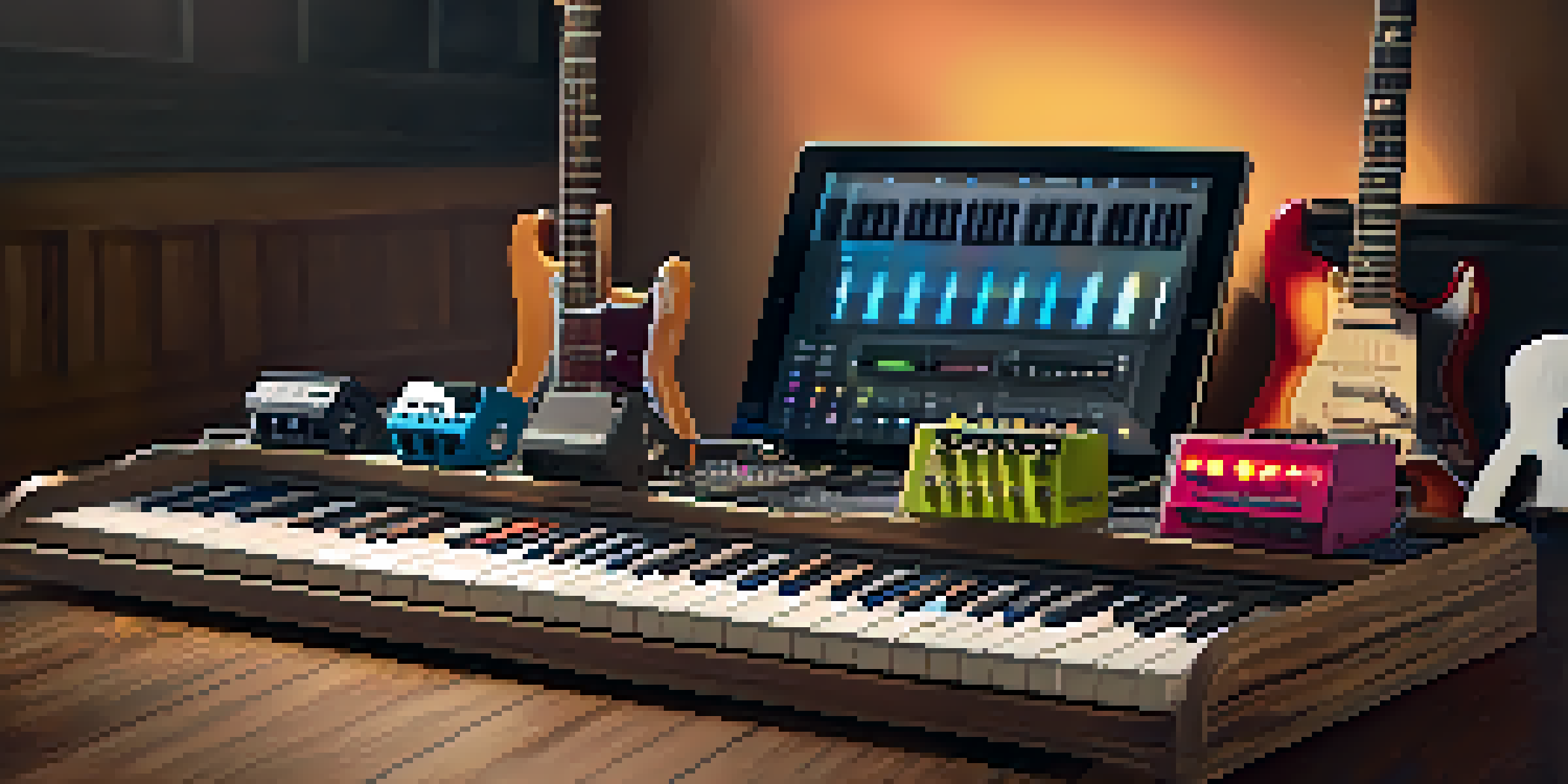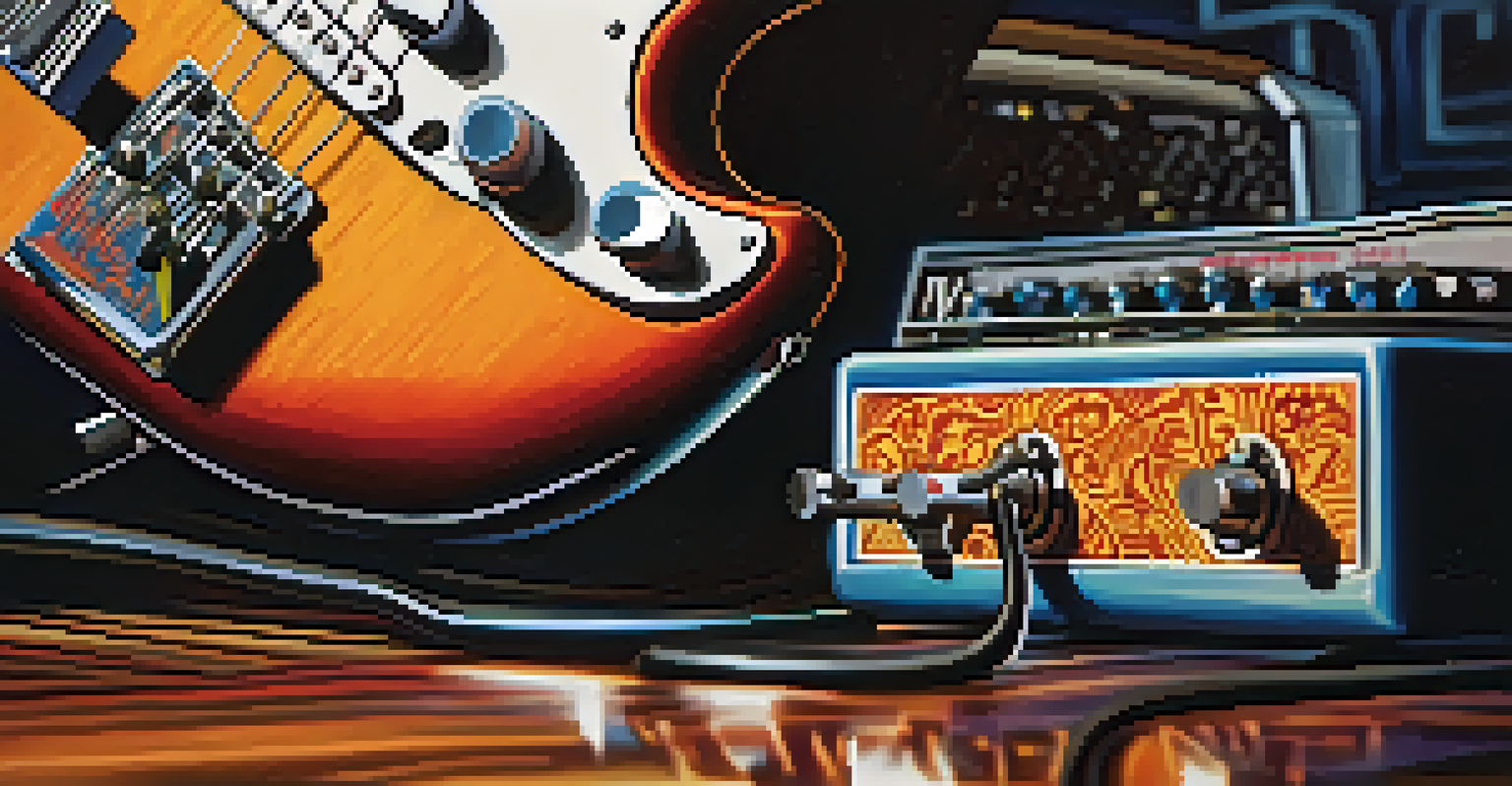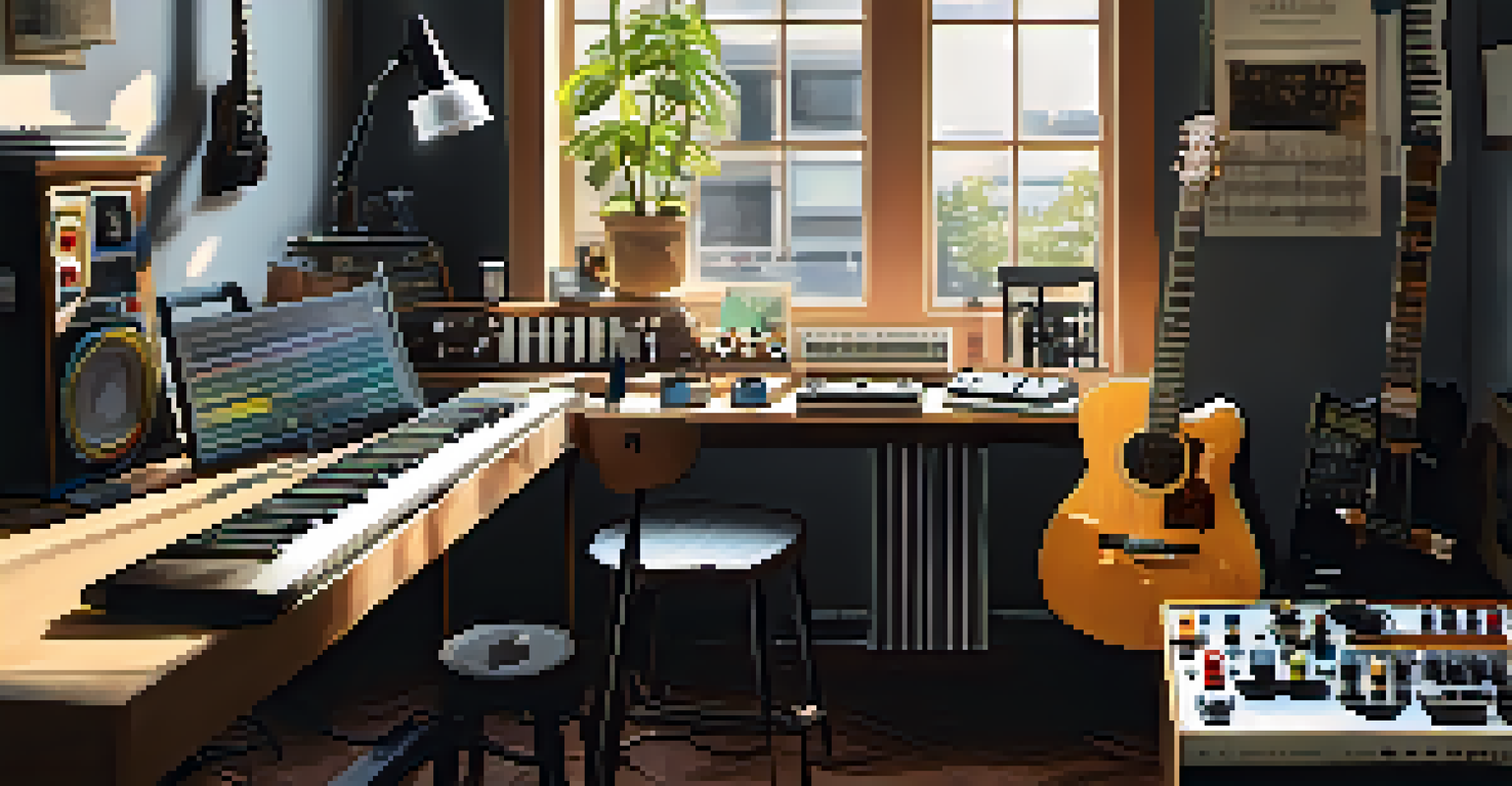Pedalboards Explained: Organizing Your Guitar Effects

What Is a Pedalboard and Why Use One?
A pedalboard is a flat surface that holds your guitar effects pedals, making it easier to manage and use them during performances or practice. Think of it as a stage for your pedals, where they can shine together in harmony. By organizing your effects on a pedalboard, you also minimize the risk of tripping over loose cables and creating chaos on stage.
Music is a world within itself; it’s a language we all understand.
Using a pedalboard simplifies your setup, allowing you to connect multiple effects with ease. Imagine walking into a gig, and instead of fumbling with individual pedals, you have everything neatly arranged and ready to go. This not only saves time but also enhances your overall performance, letting you focus on what matters most—playing music.
Additionally, a well-organized pedalboard can enhance your sound quality. By ensuring that your pedals are connected in a logical order, you can create a more cohesive sound that flows seamlessly from one effect to another. This organization can elevate your tone and overall sound, making your performances more enjoyable for both you and your audience.
Choosing the Right Pedalboard for Your Needs
Selecting the right pedalboard can feel overwhelming, given the variety available on the market. Factors like size, material, and layout are essential to consider. For instance, if you plan to travel frequently, a lightweight and portable board would be ideal, while a larger board may be suitable for studio work.

Another key aspect is the number of pedals you intend to use. If you have a collection of effects that you love, a larger board with more space for expansion might be the way to go. However, if you prefer simplicity, a smaller board that accommodates just your essential pedals can keep your setup streamlined and manageable.
Pedalboards Simplify Performance
A pedalboard organizes your effects, making setups more efficient and reducing stage clutter.
Lastly, consider your aesthetic preferences. Pedalboards come in various designs, from sleek wooden finishes to more utilitarian metal frames. Choose a style that reflects your personality as a musician and complements your gear, ensuring that your pedalboard not only serves a functional purpose but also looks great on stage.
Essential Components of a Well-Organized Pedalboard
A well-organized pedalboard typically includes a power supply, patch cables, and pedal risers or spacers. A reliable power supply is crucial for keeping your pedals energized, especially during long gigs. Think of it as the heart of your setup, providing the necessary juice to keep everything running smoothly.
The beautiful thing about learning is that no one can take it away from you.
Patch cables are vital for connecting your pedals in the desired order, and investing in high-quality cables can make a significant difference in your overall sound. Just like good ingredients matter in a recipe, quality cables ensure that your tone remains intact without unwanted noise or interference. So, it's worth taking the time to select the right ones.
Lastly, consider using risers or spacers to layer your pedals effectively. By elevating certain pedals, you can make them more accessible and easier to manipulate on stage. This little adjustment not only enhances your workflow but can also prevent accidental stomping on the wrong pedal during a performance.
Best Practices for Arranging Your Pedals
When it comes to arranging your pedals, the order of effects can dramatically impact your sound. A common practice is to place your distortion or overdrive pedals at the beginning of your signal chain. This way, they can shape your tone before any modulation or delay effects are applied, much like laying a solid foundation before building a house.
Next, consider placing modulation effects, such as chorus or flanger, followed by delay and reverb pedals. This arrangement allows for a more natural sound, helping each effect complement the others. Think of it as a conversation among your pedals, where each one contributes to the overall message without drowning out the others.
Choosing the Right Pedalboard
Selecting a pedalboard involves considering factors like size, number of pedals, and personal style.
Finally, don't forget to leave some space for experimentation. Sometimes, the best sounds come from unexpected combinations. So, allow yourself the freedom to rearrange and tweak your setup until it feels just right. After all, music is about creativity, and your pedalboard should be a reflection of that spirit.
Troubleshooting Common Pedalboard Issues
Even with a well-organized pedalboard, you may encounter issues from time to time. One common problem is noise interference, which can occur due to poor cable connections or proximity to other electronic devices. If you hear unwanted hums or buzzes, it might be time to check your cables and ensure that your pedals are properly grounded.
Another issue is the accidental activation of pedals, which can be frustrating during live performances. To prevent this, consider using pedalboard risers or switching to pedals with a more reliable footswitch design. By taking these precautions, you can maintain better control over your effects and avoid any mishaps on stage.
Lastly, if you notice a decrease in sound quality, it might be worth examining your power supply. Insufficient or inconsistent power can lead to degraded performance from your pedals. Investing in a high-quality power supply can help you avoid these issues and ensure that each effect delivers its best sound every time you play.
Maintaining Your Pedalboard for Longevity
Regular maintenance is key to keeping your pedalboard in great shape. Start by periodically checking all cable connections and ensuring they're secure. Loose cables can lead to audio dropouts or unwanted noise, so it's essential to give them a little love and attention from time to time.
Cleaning your pedals is another important aspect of maintenance. Dust and debris can accumulate over time, affecting performance and longevity. A simple wipe-down with a soft, dry cloth can help keep your gear looking fresh and functioning well, just like how you’d take care of any other valuable instrument.
Creativity in Pedal Arrangements
Experimenting with pedal arrangements can lead to unique sounds and enhance your musical expression.
Lastly, consider revisiting your pedal arrangement every so often. As your musical style evolves, so might your needs for effects. Keeping your pedalboard updated and tailored to your current sound can ensure that it remains an effective tool in your musical arsenal.
Exploring Creative Possibilities with Pedals
One of the most exciting aspects of using a pedalboard is the creative possibilities it offers. With countless effects available, you can experiment with different combinations to discover your unique sound. Think of your pedalboard as a palette, where each effect is a color you can mix and match to create something truly special.
For instance, layering a delay pedal with a reverb can create lush soundscapes that transport your audience to another world. Similarly, using modulation effects in conjunction with distortion can add depth and character to your tone. Don't be afraid to try unconventional setups; sometimes, the best results come from stepping outside the box.

Ultimately, your pedalboard should be a reflection of your artistic vision. Embrace the journey of exploration and allow your creativity to shine through your effects. Remember, music is about expressing yourself, and your pedalboard is just one tool in your toolbox to help you do that.